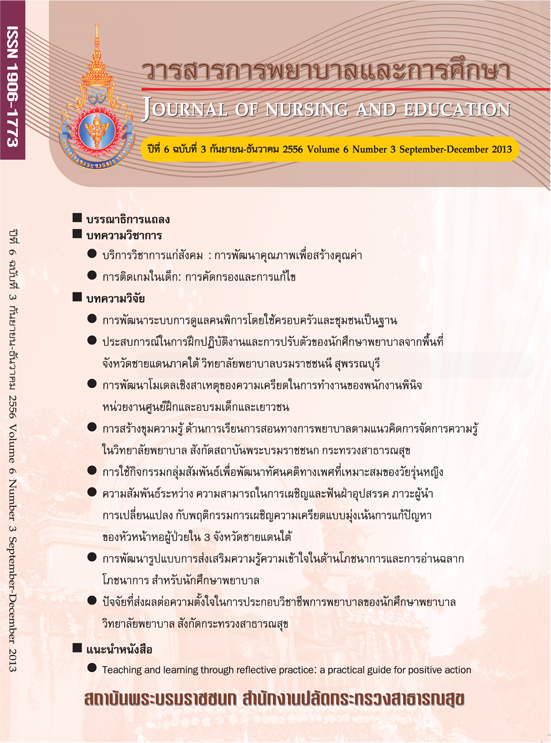การพัฒนาระบบการดูแลคนพิการโดยใช้ครอบครัวและชุมชนเป็นฐาน
คำสำคัญ:
Developing disabled caregiving system, Family and Community Based, Participatory action researchบทคัดย่อ
บทคัดย่อ
การศึกษาครั้งนี้เป็นการวิจัยเชิงปฏิบัติการแบบมีส่วนร่วมเพื่อพัฒนาระบบการดูแลคนพิการโดยใช้
ครอบครัวและชุมชนเป็นฐาน ภายใต้กรอบการดำเนินงานการฟื้นฟูสมรรถภาพคนพิการ และแนวคิด
นวัตกรรมการดูแลภาวะเรื้อรัง ซึ่งเน้นการพัฒนาระบบการดูแลคนพิการโดยครอบครัว หุ้นส่วนในชุมชน และทีมสุขภาพเชิงรุกที่มีปฏิสัมพันธ์กับคนพิการโดยตรง (Micro system) และเชื่อมโยงเข้ากับระบบของการดูแลสนับสนุนขององค์กรในชุมชน ได้แก่ องค์กรปกครองส่วนท้องถิ่น ที่มีปฏิสัมพันธ์กับคนพิการทางอ้อม (Meso
system) กลุ่มตัวอย่างที่ใช้ในการศึกษาประกอบด้วย คนพิการ ญาติผู้ดูแลและครอบครัว และผู้มีส่วนเกี่ยวข้องกับการดูแลคนพิการ (บุคลากรด้านสุขภาพ ตัวแทนองค์กรส่วนท้องถิ่น/ชุมชน) จำนวน 124 คน ในพื้นที่ต้นแบบ อำเภอแห่งหนึ่งในจังหวัดจันทบุรี และผู้เชี่ยวชาญ จำนวน 30 คนที่เลือกแบบเจาะจง กระบวนการพัฒนาประยุกต์ใช้การมอง การคิด และการปฏิบัติ ที่มีลักษณะเกลียวปฏิสัมพันธ์ การเก็บรวบรวมข้อมูลใช้ การสนทนากลุ่ม การสัมภาษณ์เชิงลึก การระดมความคิด และการสังเกต ส่วนการวิเคราะห์ข้อมูลใช้วิธีการวิเคราะห์เชิงเนื้อหา
ผลการศึกษาได้ 2 นวัตกรรมการดูแลคนพิการ คือ นวัตกรรมที่ 1 รูปแบบระบบการดูแลคนพิการโดยใช้ครอบครัวและชุมชนเป็นฐาน ประกอบด้วย 4 แนวคิดหลัก คือ (1) การดูแลต่อเนื่องที่ไร้รอยต่อ (2) ความเข็มแข็งของครอบครัว (3) ศักยภาพของชุมชน (4) การเรียนรู้ร่วมกันสู่ความสำเร็จตามเป้าหมาย และ 8 หลักการสำคัญ คือ (1) บทบาทของครอบครัว (2) บทบาทของภาคีเครือข่าย (3) การเข้าถึงบริการ (4) การประสานงานที่ไร้รอยต่อ (5) การจัดเตรียมบริการที่เหมาะสม (6) การมีส่วนร่วมของครอบครัวและคนพิการ (7) การเคารพในศักดิ์ศรีของคนพิการ และ (8) ความรับผิดชอบในสิ่งที่กระทำ นวัตกรรมที่ 2 WE CAN DO by TIM เป็นกระบวนการที่ประสบความสำเร็จในการพัฒนาภาคีหุ้นส่วน ซึ่งประกอบด้วย 7 ขั้นตอน 3 คุณลักษณะ คือ 1)W-Willing การสร้างความตั้งใจ มุ่งมั่น และความร่วมมือในการดูแลคนพิการ 2) E-Exploration การร่วมค้นหา มองและสะท้อนปัญหา ความต้องการ 3) C-Cognition การรวมพลังร่วมคิดเพื่อการพัฒนา 4) A-Acting การร่วมปฏิบัติตามระบบการดูแลที่พึงประสงค์ 5) N-Notice การร่วมประเมินและให้ข้อสังเกตการปฏิบัติ 6)
D-Decoration การร่วมแสวงหาและพัฒนาต่อ 7) O-outstanding การสร้างความโดดเด่น ความต่อเนื่องและ ความยั่งยืนด้วยการเพิ่มพลัง 3 คุณลักษณะ (TIM) คือ (1) ภาคีหุ้นส่วนจิตอาสาต้องทำงานเป็นทีมในการดูแลคนพิการ (T-Team approach) (2) ทีมภาคีหุ้นส่วนจิตอาสาต้องมีแรงบันดาลใจในการดูแลคนพิการ (I-Inspiration) (3) ทีมภาคีหุ้นส่วนจิตอาสาต้องมีความรู้สึกร่วมในการทำเพื่อมวลมนุษยชาติ (M-Mankind)
ผลการศึกษานี้เสนอแนะว่า การพัฒนาระบบการดูแลคนพิการโดยใช้ครอบครัวและชุมชนเป็นฐานและการใช้กระบวนการ WE CAN DO by TIM เป็นแนวทางและกลวิธีที่สำคัญสำหรับ บุคลากรด้านสุขภาพ ด้านการองค์กรส่วนท้องถิ่น และแกนนำชุมชน ที่จะนำไปใช้ในการเสริมสร้างพลังอำนาจและพัฒนาคุณภาพชีวิตของคนพิการอันจะนำไปสู่การดำรงชีวิตอิสระของคนพิการต่อไป
คำสำคัญ : ระบบการดูแลคนพิการ ครอบครัวและชุมชนเป็นฐาน กระบวนการพัฒนาภาคีหุ้นส่วน
การวิจัยเชิงปฏิบัติการ
Abstract
This participatory action research (PAR) aimed to develop a disabled caregiving system based on families and communities using Community-Based Rehabilitation (CBR) and Innovative care for chronic conditions (ICCC) as theoretical frameworks. The study conducted in a rural area of eastern Thailand involved spiral action process of look-think-act. Participants composed of 1).124 volunteering disabled people, caregivers and stakeholders including professionals in disability
services and non-professionals in community and 2). 30 experts. Quantitative and qualitative data were collected involving in-depth interviewing, focus group, brainstorming, and observation methods. The data were analyzed by content analysis.
Through development cycle, three innovations were developed. First, the disabled caregiving system based on families and communities aimed to support for disabled people, which composed of four concepts including 1) Seamless Continuing Care 2) Family Strength 3) Community capacity and 4) Collaborative Learning to Goal Success. It was operated by eight principles: Family Role, Network Role, Accessibility, Seamless co-ordination, Providing appropriate services, Family and disabled people participation, Human dignity respectation, and Accountability. Secondly, the development process, namely "WE CAN DO", consisted of 7 stages: 1) creating personal willingness and cooperation, 2) exploring and reflecting problems /needs, 3) sharing cognition and making a caring model, 4) acting a model, 5) evaluating and exploring notice, 6) decorating a caring model, 7) promoting and
continuing volunteer partner network outstanding. Finally, stakeholders should have 3 characteristics, namely "TIM", consisted of teamwork approach, inspiration, and willingness to act for mankind.
This study suggests that developing disabled caregiving system based on families and
communities along with using the process of WE CAN DO by TIM as a guideline and a strategy are essential to health personnel, local administrative personnel and community leader for performing community services in order to enhance empowerment and increase disabled people's quality of life and independent living.
Keywords : Developing disabled caregiving system, Family and Community Based, Participatory action research






